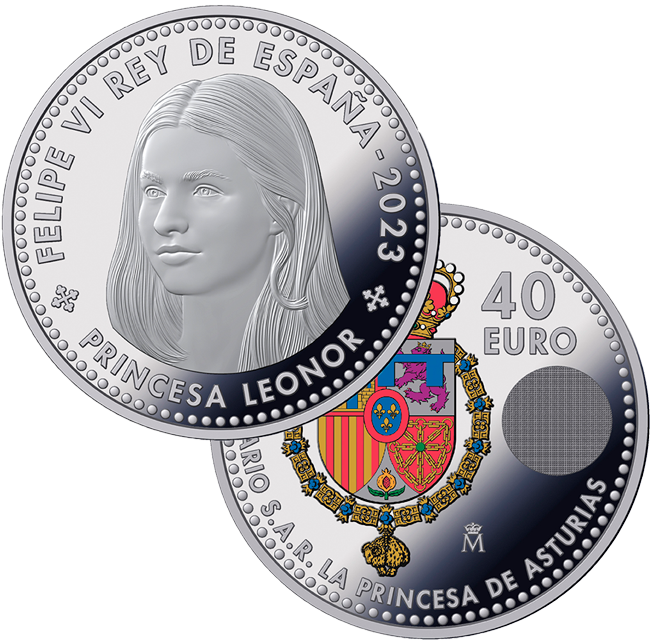
Woman and money: myth and power
Women have played a key role in the history of money for centuries. It does not matter if they were goddesses, nymphs or queens, revered mythological deities or real people of flesh and blood, from diverse backgrounds and conditions. If all these female characters have something in common, they have left the mark in very different historical contexts.
“Woman and money: myth and power” aims, precisely, to be a trip to the past where you learn first-hand what the history of each of these women was, why they are remembered and, ultimately, what caused them, even today, we can admire them on the side of a coin.
DECADRACMA DE LA DIOSA TANIT
Tanit is the titular goddess of Carthage. She was the Great Punic Mother, her attributions were fertility, sexuality, protector in the afterlife, of the astral sky and the lunar cycles, but also of war and guardian of the progress of Carthage. She was the successor of the goddess Astarte worshipped in Phoenicia. The Carthaginians, as heirs of the Phoenicians, also worshipped the male divinities Melqart (identified with Hercules) and Baal Hammon (Saturn), but the cult of the goddess gradually took over from the end of the 5th century BC and became very popular in North Africa, Sardinia, Sicily and the Spanish Levant, but it is particularly notable on the island of Ibiza where several shrines to the goddess are known.
This silver decadrachm or pentasicle dates from 260 BC and is a coin of great value and formidable workmanship. Minted in Sicily, the obverse shows the head of the goddess with her hair tied back and a crown of ears of wheat, while the reverse shows a Pegasus and the Punic inscription ‘b’rst’ (on the earth). It weighs 37.73 g.
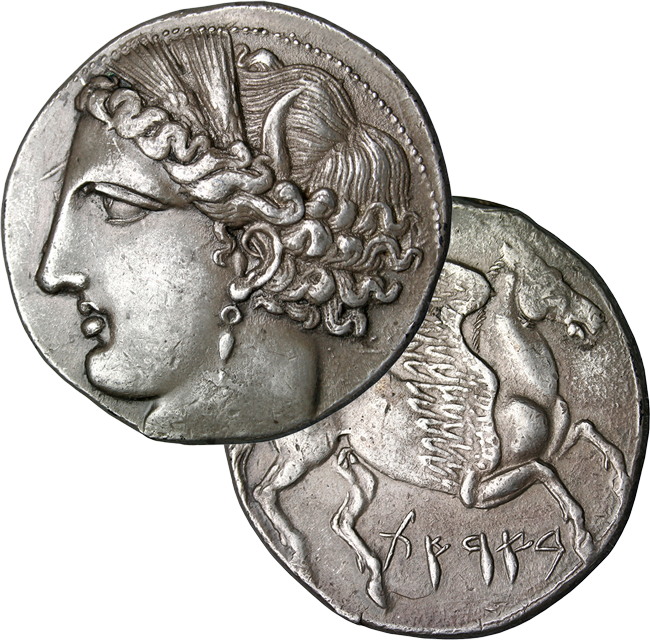
OCTODRACMA DE ARSÍNOE II
Arsinoe II (c.316-268 BC) was one of the most prominent queens of the Ptolemaic dynasty in Egypt. Daughter of Berenice and Ptolemy, general of Alexander the Great and founder of the dynasty. Married at a very young age to Lysimachus, king of Thrace and Macedonia and friend of her father, Arsinoea was a figure of great importance and received honours in the city of Ephesus, which changed its name to Arsinoea (294-289 BC).
Her involvement in the death of Lysimachus’ son Agathocles and the subsequent death of Lysimachus himself in battle made Arsinoea a fugitive queen pursued by King Seleucus I. Her marriage alliance with her half-brother Ptolemy Ceraunus was a terrible episode, as he ordered the murder of her three sons, of whom only the eldest was spared. Arsinoe’s eventful life took her to Egypt where she became queen by marrying her brother Ptolemy II. According to Posidippus of Pella, Arsinoe went on to win three chariot races at the Olympic Games before her death.
This gold octodrachm (mnaieion) minted in the time of Ptolemy Arsennius II’s son, Ptolemy, at the Sidon mint in 243/2 BC shows on the obverse the head of Queen Arsennius II with veil and crown identified with the goddess Artemis. On the reverse is a double cornucopia decorated with the legend: APΣIN0HΣ ФIЛAΔEЛФ0Y (Arsinoe Philadelphos) and the monograms E (date) ΣI-HЛ (Sidon). The piece has a diameter of 27 mm and weighs 27,62 g.
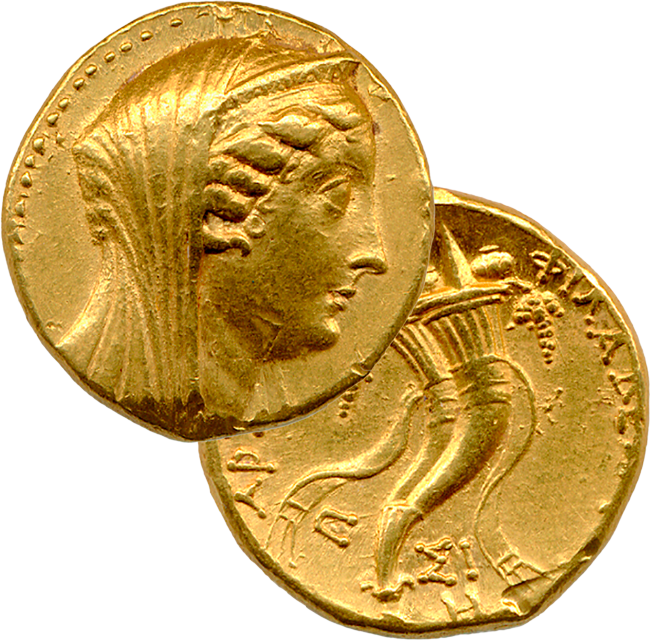
DECADRACMA DE ARETUSA
Arethusa was a naiad, that is, a nymph of the freshwater areas. Legend has it that Arethusa wanted to bathe in the river Alpheus in Greek Arcadia, then the god of the river fell in love with her and began to pursue her. Arethusa asked for help from the goddess Artemis, who transformed her into a stream of water so that she could flee from her pursuer. After a long flight under the sea, Arethusa appeared on the island of Ortigia in Sicily, gushing like a spring, but was overtaken, cornered and enveloped by Alpheus. There, next to the city of Syracuse remains the spring of Arethusa, a gushing fountain of fresh water, in a circle of papyrus plants, forever surrounded by a salt lake.
The decadrachm of Syracuse is a piece of art. Minted between 405 and 400 BC it shows on its obverse the beautifully carved head of Arethusa surrounded by dolphins symbolising the sea, wearing a papyrus crown. The reverse shows a triumphant chariot and war trophies. This piece is attributed to the famous engraver Evainetos, weighs 42.86 g and has a diameter of 35.1 mm.
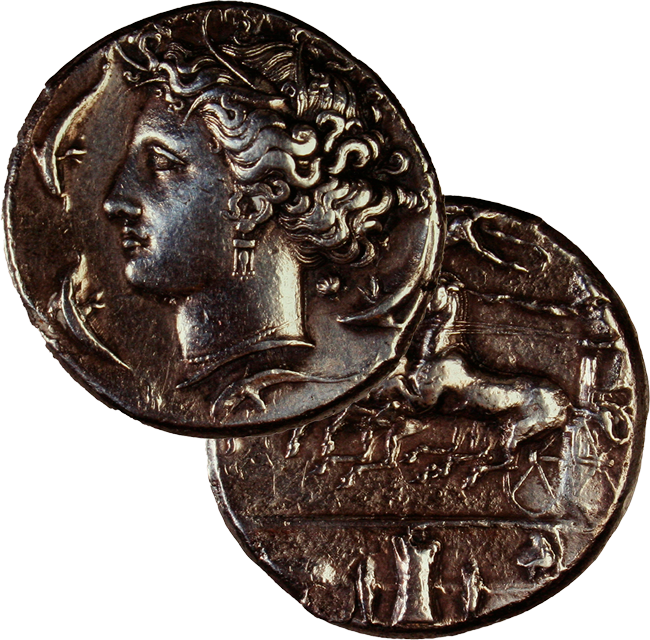
DENARIO DE JUNO MONETA
Juno Monetapatron goddess of Rome, her epithet means she who “warns” or “admonishes”. Roman tradition relates that during the invasion of the Gauls in 390 BC, the sacred geese of Juno on Capitoline Hill began to squawk furiously at the invading Gauls, alerting the Roman guards who repelled the attack. The temple of Juno Moneta was built on the hill and consecrated in 344 BC. This temple was associated with the minting of coins, a word that derives from the epithet of the goddess, as the coin warns and advises.
The denarius of Juno Moneta dated 46 BC BC shows on its obverse side the head of the goddess with her hair tied back and the legend: MONETA. The reverse shows tools for the minting of coins (tongs, wedges and hammer) and the name of the magistrate T. CARISIUS. The coin weighs 3.79 g.
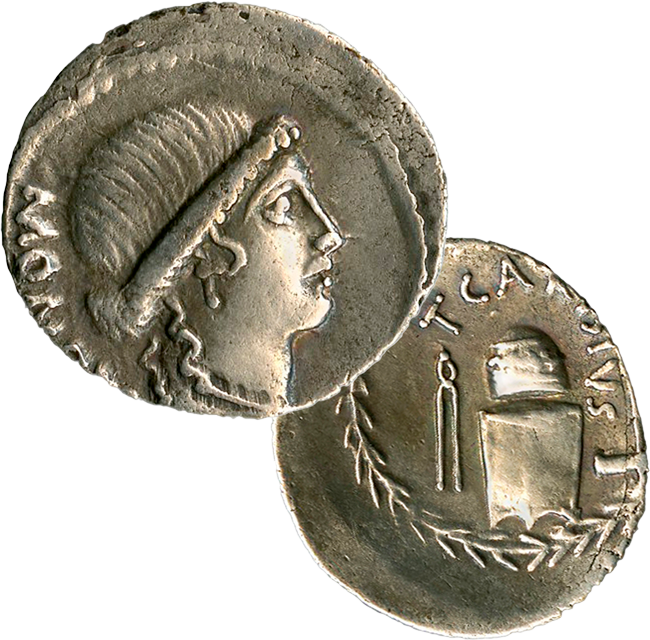
SESTERCIO DE AGRIPINA LA MAYOR
Agrippina the Great was born between 13 and 15 BC. She was the wife of the Roman general Germanicus and during his campaigns in Germania, she took an active part in preventing the demolition of a bridge that would have left many soldiers in enemy territory, who were received by Agrippina herself with food and medicine. He had to suffer the repression of his family by the Emperor Tiberius, who ordered the death of Agrippina’s mother and brother. After the death of Germanicus and after many vicissitudes, Agrippina was exiled to the island of Pandataria and left to starve to death, condemned by Emperor Tiberius in 33 AD. She was also the mother of the future emperor Caligula and of Agrippina the younger, who was also empress, wife of Claudius and mother of Nero.
The sestertius of Agrippina was minted during the reign of her son Caligula (AD 37-41). It bears her portrait on the obverse and the legend: AGRIPPINA M F MAT C CAESARIS AVGVSTI (Agrippina, daughter of Marcus, mother of Gaius Caesar Augustus). The reverse depicts her hearse with the legend: SPQR / MEMORIAE / AGRIPINAE (Roman Senate and People, in memory of Agrippina). The coin weighs 27.8 g and has a diameter of 35 mm.

SESTERCIO DE JULIA DOMNA
Julia Domna (160-217) was a famous philosopher of great influence in her time. Married to Emperor Septimius Severus, she became the first widowed empress of the Roman Empire when she was widowed in 211, receiving the titles of “Pia Felix Augusta” and “Mater Patriae”, which gave her the greatest influence over the state ever acquired by a Roman woman. Mother of the emperors Geta and Caracalla, she committed suicide in 217 after the latter’s assassination.
The sestertius of Julia Domna minted between 211 and 217 shows on the obverse the portrait of the empress with an Egyptian hairstyle and the legend: IVLIA PIA FELIX AVG (Julia Pia Felix Augusta). The reverse shows the goddess Juno with her attributes and the legend: IVNO S.C. (Juno, Senate Consul). The piece weighs 26.3 g and has a diameter of 32.7 mm
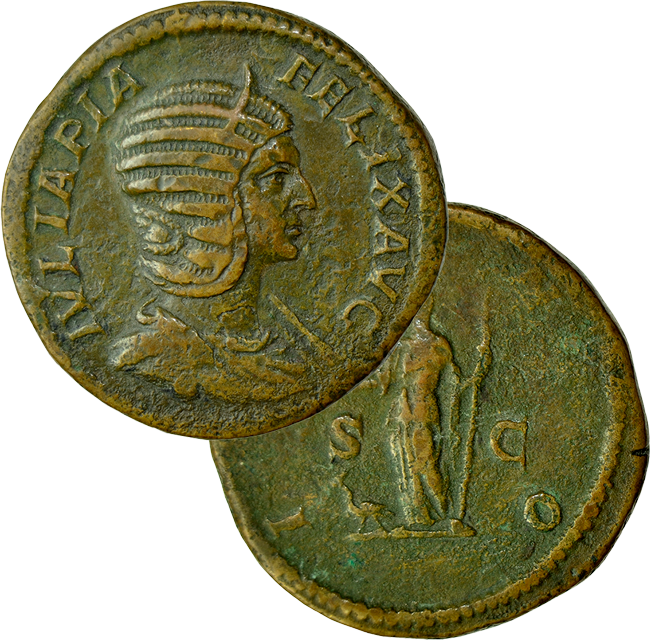
DINERO DE URRACA I DE LEÓN
Born in 1081, Urraca was Queen of León between 1109 and 1126, the first daughter of Alfonso VI and married to Raymond of Burgundy at the age of only 8. She had two sons, Sancha and Alfonso, and by 1096 she was queen of the newly created Kingdom of Galicia.
After Raymond’s death, Urraca grew as a political figure. She became queen of León in 1109 on the death of her father and the death of her brother the previous year. Forced to marry the Aragonese monarch Alfonso the Battler, their union did not appease the territorial disputes. His repudiation of her in 1114 was a relief for Urraca and for the León nobility, who did not want the union. From then on, Urraca ruled alone until her death in 1126, facing numerous conflicts with both the Almoravids and the Portucalense County. She was the first woman in Europe to rule in her own right. Urraca’s cross-and-crismon money was minted during her reign (1109-1126). The obverse bears a flowered cross with the legend: VRRACAREGI (Queen Urraca). On the reverse is the chrism with the alpha and omega and the legend alluding to its mint: LEOCIVITAS (City of León). The coin is made of fleece (a mixture of silver and copper), weighs 0.71 g and has a diameter of 17.73 mm.
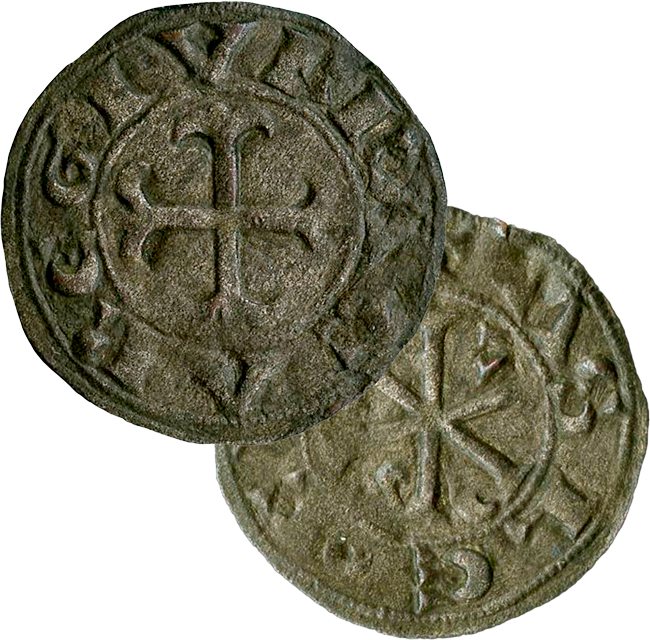
4 EXCELENTES DE ORO DE LOS REYES CATÓLICOS
Isabella I of Castilla (1451-1504) needs no introduction. The history of her reign and the achievements of the kingdom of Castile during it is well known. Crowned in 1474, after her victory in the War of the Castilian Succession, she modernised the government and administration of the kingdom, gaining powers for the crown to the detriment of the nobility. It was also her initiative to support Christopher Columbus’s expedition, which led to the discovery of America and the largest incorporation of territories that the kingdom was to receive. The first instructions for administering the new American possessions also came from the queen. Together with Ferdinand of Aragon, she always ruled on an equal footing, an aspect that was well reflected in the coinage.
The 4 excellent gold coins of the Catholic Monarchs, produced from 1497 onwards , were of exceptional quality and purity and were highly prized for foreign trade. Symbol of the prosperity of the kingdom of Castile, the coin bears on its obverse side the image of the busts of Isabella and Ferdinand facing each other, the mint mark of Segovia where it was minted (a small aqueduct), the value mark ‘4’ and the legend: FERNANDVS ET HELISABET REX ET REG (Ferdinand and Isabella, king and queen). The reverse bears the coat of arms of the monarchs with the eagle of St. John and the legend: SVB UMBRA ALARVM TVA (Under the shadow of your wing). The coin weighs 13.71 g and has a diameter of 33.7 mm. This type of coin was minted until 1543 in the time of Charles I.
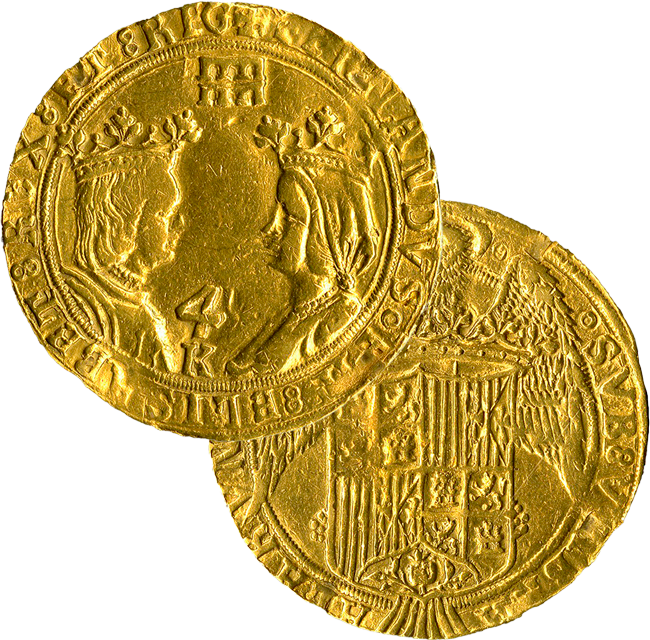
TRIPLE DUCATÓN DE ISABEL Y ALBERTO
The Infanta of Spain, Isabella Clara Eugenia of Austria (1566-1633), was the daughter of Philip II and Isabella of Valois. Her precocious apprenticeship in writing and reading, for which she had a great passion, enabled her to carry out a great deal of administrative and diplomatic work at the court of Philip II, and she was a person in whom the monarch had the utmost confidence. The monarch gave her the Netherlands as a dowry after her marriage to Archduke Albert of Austria in 1599. She was sovereign and then governor of the Netherlands until her death in 1633 and alone since her husband’s death in 1621. In a terribly turbulent period, in which the insurrection in those territories generated numerous conflicts, most notably the capture of Breda in 1625, although, in general, during her rule Elizabeth was noted for seeking solutions that favoured coexistence.
The silver Triple Ducatone Triple Ducaton minted in Antwerp dated 1619. It is a coin of formidable size, 42 mm in diameter and weighing 90.98 g with a considerable thickness of 4 mm. Made for circulation in the Duchy of Brabant, the obverse shows a superb engraving of the dukes’ busts, with Isabella’s in a secondary position, and bears the legend: ALBERTVS ET ELISABET DEI GRATIA 1619 (Albert and Isabella by the Grace of God 1619). The reverse bears the coat of arms of both with the legend: ARCHID.AVST DUC-ES BVRG BRAB.Z (Archduke of Austria, dukes of the cities of Brabant).
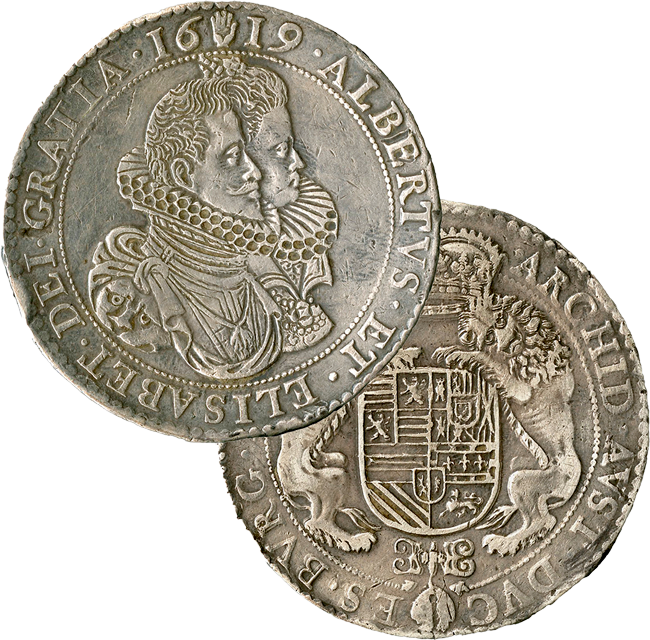
5 GUINEAS DE ORO DE ANA I DE GRAN BRETAÑA
Ana Stuart (1665-1714) would go down in history as Anne I of Great Britain. Queen of England from 1702, she became Queen of Great Britain by virtue of the Act of Union of 1707 between the kingdoms of England and Scotland. Very interested in the politics of her time, she regularly attended debates in the House of Lords incognito. She experienced England’s involvement in the War of the Spanish Succession (1701-1714) on the side of the Austracist side against the future Philip V of Bourbon. Britain was to retain Gibraltar after the war. Anne I can be said to have ruled England successfully at a crucial period in her history thanks to the aforementioned acquisitions, but she was also noted for her promotion of charitable causes. She died in 1714.
The 5 gold Anne I Guineas are the first type denominated Post-Union by Britain. The obverse shows the portrait of the queen and the legend: ANNA DEI GRATIA (Anne by the Grace of God). On the reverse are four shields in the form of a cross and the legend: MAG. BRI.FR. ET.HIB. REG 17-06 (Queen of Great Britain, France and Ireland). The piece weighs 41.58 g and is 38 mm in diameter.
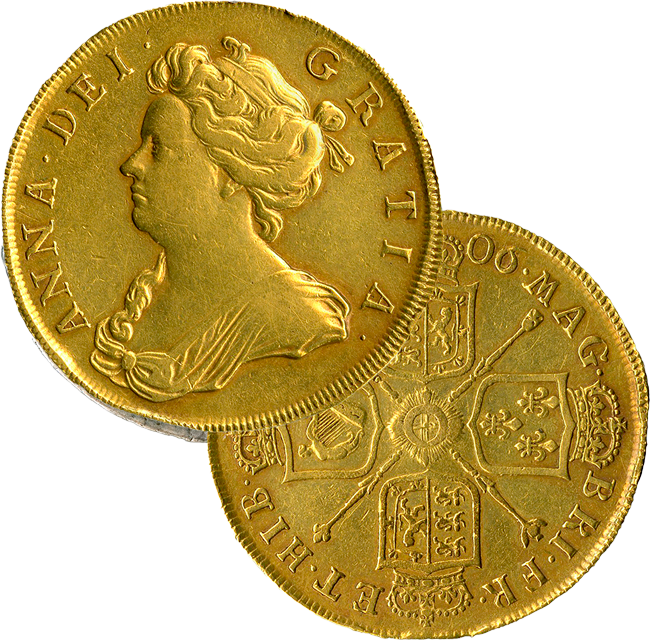
20 REALES DE ISABEL II
Daughter of Ferdinand VII and named Heir to the throne at the age of three, Isabella II (1830-1904). Her reign was always under the tutelage of her mother María Cristina de Borbón (1833-1840) and then of General Espartero (until 1843), both directly. The coming of age did not give Isabella II the reins of state, as the different groups of power, the Moderate Party and the Progressive Party, which were spurred on by different pronouncements and revolutions, succeeded each other at the helm of government. The legitimacy of the queen was questioned after her appointment by her uncle Carlos María Isidro, leading to the Carlist Wars (1833-1840 and 1846-1849) and various uprisings. The turbulent reign of Isabella II ended in 1868 with the Glorious Revolution, which forced her into exile in France. She died in Paris 36 years later, without ever regaining any relevance after the Bourbon restoration of 1874, a queen who never exercised effective power and probably never wanted it for herself.
The 20 reales silver coin of Isabella II, minted in 1835, shows a portrait of a five-year-old girl with the legend: ISABEL 2ª POR LA GRACIA DE DIOS 1835 (ISABEL 2ª BY THE GRACE OF GOD 1835). On the reverse, the coat of arms crowned with the legend: QUEEN OF SPAIN AND THE INDIES and the 20 reales value mark. This coin was minted at the Real Casa de la Moneda in Madrid, engraved by Mariano González de Sepúlveda. It has a diameter of 37 mm and weighs 27 g.
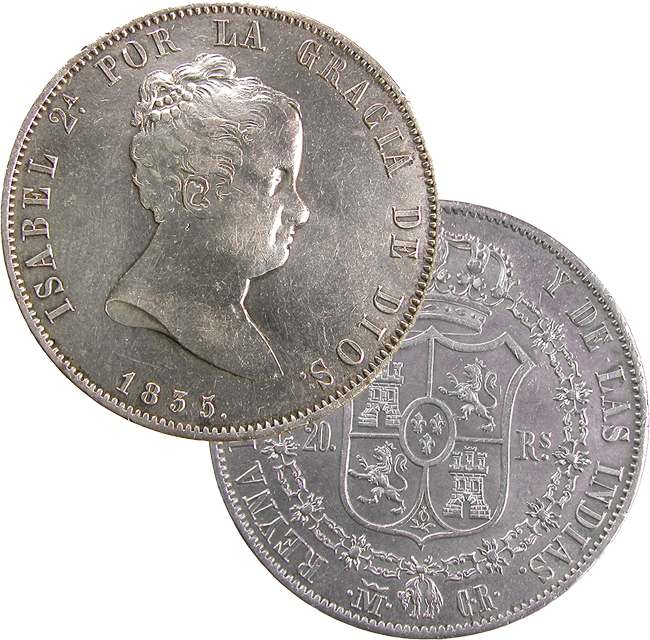
MONEDA CONMEMORATIVA DE 40 EUROS DE S.A.R. LA PRINCESA DE ASTURIAS DOÑA LEONOR DE BORBÓN
The eldest daughter of Their Majesties King Felipe VI and Queen Letizia of Spain. Her Royal Highness, Doña Leonor de Borbón, has been the heir to the crown since her father was proclaimed King on 19 June 2014. Since then, she has held the title of Princess of Asturias. Until 2023, she studied the International Baccalaureate at the UWC Atlantic College in Wales, United Kingdom. In the same year, she began her military training at the General Military Academy, and plans to attend two further military training courses at the Naval Military School and the General Air Academy. When she came of age on 31 October 2023, she took the oath of office before the Spanish Parliament. As heir to the throne and a military officer, she has already participated for the first time in the military Easter on 6 January 2024.
The commemorative silver coin with a face value of €40, minted at the RCM-FNMT, shows the effigy of Her Royal Highness the Princess of Asturias, Doña Leonor de Borbón y Ortiz on the obverse, with the legend: FELIPE VI KING OF SPAIN and the year of mintage 2023. The reverse shows the coat of arms of Her Royal Highness the Princess of Asturias in colour, with the legend: 18 ANNIVERSARY H.R.H. THE PRINCESS OF ASTURIAS and the face value of 40 €. The coin has a diameter of 33 mm and weighs 18 g.
We hope you have enjoyed this tour and have learned a little more about all these empowered women, authentic icons who transcended their time and whose spirit inspired and will continue to inspire women of later generations around the world.
